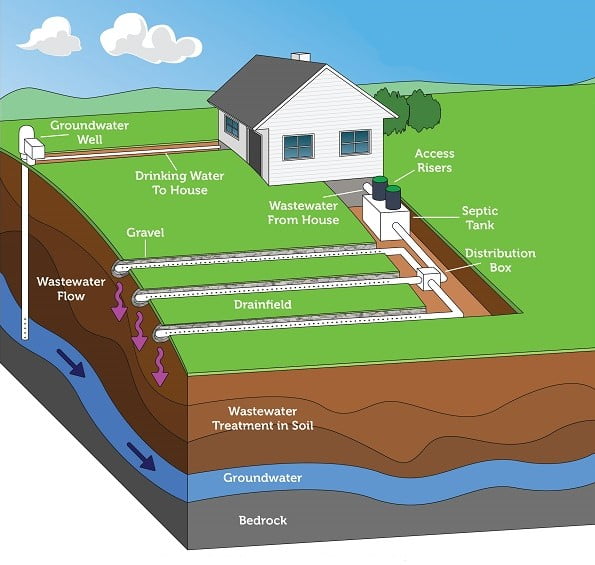What is a septic system? Wastewater carries disease-causing bacteria, infectious viruses, household chemicals and excess nutrients that must be removed. If you are not hooked up to city sewer or a sanitary district, your septic system is your wastewater treatment facility. Though it is much less complicated than a city’s facilities, it serves a similar purpose: to protect public health and prevent pollution. Do you need a new septic?
A typical septic system consists of two parts: the septic tank and the drainfield. The septic tank retains the solids, greases and oils, which would clog your drainfield. Anaerobic bacteria (in the absence of oxygen) digest the solids. They are not an efficient bacteria and leave sludge on the bottom of the tank that must be pumped out on occasion. Baffles at each end of the tank keep the floating greases and oils (scum layer) from entering and clogging the drainfield.
Effluent, the liquid waste, will then go into the drainfield. Suspended solids, viruses, and nutrients attach to soil particles or are trapped in soil pores, filtering the effluent. Aerobic bacteria (in the presence of oxygen) do a better job of breaking down these by-products. Large pores or shallow soils will not purify the effluent before it reaches groundwater or bedrock. Soil containing many small pores will accept water too slowly, requiring a larger drainfield.
Some areas may be better suited to aeration tanks or sand filters. These technologies are not yet widely used in Waupaca County, but are available. You may want to ask your plumber about them.
Determining Septic System Type
Before purchasing land to build on, it may be wise to have the soil tested. Some sites are not suitable for conventional septic systems. A Certified Soil Tester (CST) can determine the type of system your site will allow. Backhoe pits must be dug by the CST to determine the physical characteristics of your soil.

Alternative systems cost more, but may be needed to treat your wastewater. If the site is not suitable for a conventional system, you may be able to have one of the alternative systems. The four most common are mound, at-grade, in-ground pressure, and holding tanks.
Mound systems use approved sand fill to meet the three foot separation from groundwater or bedrock. The gravel bed is placed within the mound, and covered with fill and topsoil.
At-Grade systems are similar to the mound however, the gravel is directly on the plowed, natural soil, the sand fill is not needed for an at grade.
In-Ground Pressure systems use small diameter pipe and a pump for even distribution, and are essentially a shallow conventional system.
Holding Tanks are a last resort for areas with high groundwater, or small lots. It has the cheapest installation, since the wastes and wastewater. However, the 5-day holding capacity make maintenance costs very high. Waupaca County prohibits holding tanks for new construction.
Existing Septic Systems
Find the location and maintenance history of the existing septic tank and drainfield. Use caution, an old septic tank may be deteriorating and cave-in under human weight. Gases within a tank are deadly. Newer systems (in the 80s) and tanks will have observations pipes and/or vents to help you locate them. A drainfield that is soggy, ponded or has greener grass may have problems. A CST or plumber can evaluate the system for you.
Failing Septic Systems
A failing system is defined as one that backs up into the house, surfaces to the ground, or enters surface water or groundwater. This may be due to poor design, poor location, overloading of the system, lack of maintenance, or age. If the problem persists after the tank has been pumped, you may need a replacement system.
Financial help may be available for you. Information packets are available in the Planning & Zoning Office.
